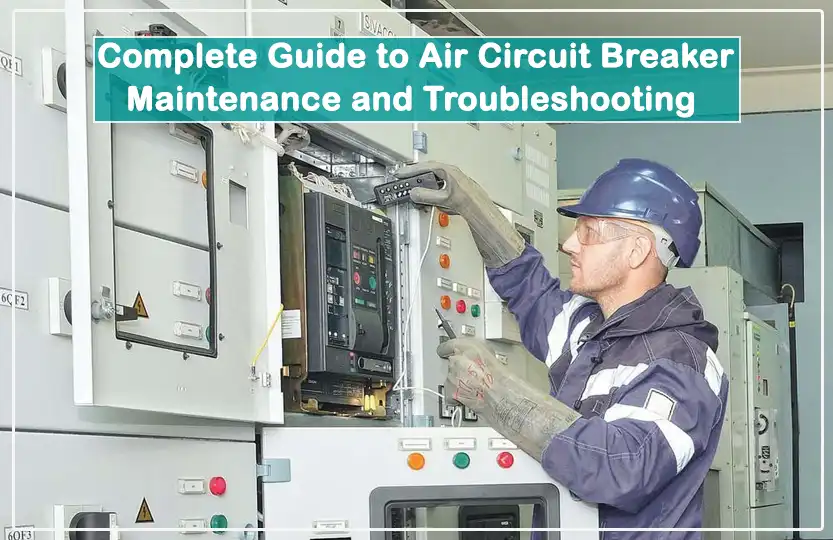
Air circuit breakers (ACBs) play a critical role in modern electrical systems by protecting against overcurrent and short circuits. Unlike other breakers that rely on insulating oils or gases, ACBs use compressed air to extinguish electrical arcs efficiently.
Though designed to be robust, regular air circuit breaker maintenance is essential to ensure optimal performance, prevent failures, and extend the device’s lifespan.
What Is an Air Circuit Breaker (ACB)?

An Air Circuit Breaker (ACB) is an electrical switching device designed to protect low and medium-voltage circuits by automatically interrupting excessive current during abnormal conditions such as overloads or short circuits. It is widely used in low-voltage applications, typically below 450V, handling currents from 800A to 10,000A to ensure safe and reliable operation.
How It Works
ACBs extinguish the arc formed during contact separation using pressurized air. This air stretches, cools, and eventually breaks the arc, ensuring the safe interruption of electrical current during fault conditions.
Key Applications of Air Circuit Breakers
ACBs are highly versatile and are widely used in various industrial and commercial environments:
Motors & Transformers:
Provide overload and short-circuit protection.
Switchgear & Busbars:
Enable safe isolation during system maintenance or upgrades.
Commercial Infrastructure:
Protect critical electrical systems like lighting, HVAC, and backup power systems.
Common Air Circuit Breaker Issues to Watch For
1.Contact Wear and Erosion
Arcing gradually degrades breaker contacts. Worn contacts increase resistance, resulting in excessive heat and poor fault interruption.
2.Insulation Deterioration
Dust, moisture, and heat can degrade insulation, lowering dielectric strength and increasing the risk of flashovers or shorts.
3.Overheating
Frequent switching operations or high ambient temperatures can cause thermal stress, damaging internal components and reducing breaker lifespan.
Air Circuit Breaker Maintenance Checklist
A systematic approach to maintenance ensures performance and safety:

✅ 1. Visual Inspection
Look for corrosion, discoloration, cracks, or loose hardware.
Check mounting brackets and mechanical linkages.
Ensure all parts are clean and undamaged.
✅ 2. Cleaning and Lubrication
Use non-abrasive cloths and approved cleaning agents.
Lubricate moving parts as per manufacturer recommendations.
Remove dust from arc chutes and mechanical assemblies.
✅ 3. Contact Inspection & Resistance Testing
Check for pitting, burning, or wear on contact surfaces.
Measure contact resistance and replace if out of spec.
Evaluate contact symmetry and alignment.
✅ 4. Insulation Resistance Test
Use a megohmmeter to assess insulation health.
Compare results against baseline data for trend analysis.
Identify potential weak spots before failure.
✅ 5. Mechanical Operation Check
Manually operate the breaker (open/close).
Check for smooth movement and responsive tripping.
Adjust linkages if needed.
✅ 6. Electrical Performance Testing
Perform high-potential (hi-pot) tests.
Verify trip unit calibration and response time.
Simulate overcurrent conditions to ensure proper tripping.
✅ 7. Safety and Environmental Checks
Follow proper lockout/tagout procedures.
Wear appropriate PPE during testing and handling.
Ground stored energy and follow high-voltage safety protocols.
Step-by-Step Guide to ACB Maintenance
1. System Isolation
Before any work begins, ensure full system lockout/tagout. The breaker and associated circuits must be de-energized to prevent accidents.
2. In-Depth Cleaning
Clean contacts with silver cleaner or alcohol.
Clear arc chutes of any buildup—avoid abrasives.
Lubricate all moving parts with recommended lubricants.
3. Compressed Air System Check
Inspect for air leaks and seal them.
Monitor the dew point of compressed air.
Regularly check grading capacitors for oil leakage.
4. Comprehensive Testing
Exercise the mechanism manually and electrically.
Conduct overcurrent trip tests to ensure reliable fault interruption.
Re-test insulation resistance for final confirmation.
Why Routine Maintenance Matters
Sticking to a well-planned ACB maintenance schedule:
Extends the lifespan of circuit breakers.
Prevents unexpected system failures.
Ensures protection for both personnel and equipment.
✅ Conclusion: Why Air Circuit Breaker Maintenance Matters
Air circuit breakers (ACBs) are vital components in electrical systems, providing essential protection against overloads, short circuits, and other electrical faults. Regular inspection, cleaning, lubrication, and functional testing are critical to maintaining their performance and extending their operational life.
Neglecting ACB maintenance can result in hazardous equipment failures, unexpected downtimes, and expensive repairs. By following a proactive maintenance schedule and industry best practices, you protect not only your equipment but also your personnel and overall operational reliability.
Whether you’re managing an industrial plant, a commercial facility, or a power distribution system, air circuit breaker maintenance is a critical responsibility. For reliable, high-performance ACBs and other industrial electrical components, trust Geetech
Frequently Asked Questions
How do you maintain an air circuit breaker (ACB)?
✅ To maintain an air circuit breaker:
Clean and lubricate all mechanical linkages and moving parts.
Inspect contacts, arc chutes, and internal components for signs of wear, pitting, or carbon build-up.
Remove dust and debris using vacuum or dry air.
Check insulation resistance using a megohmmeter.
Test mechanical operation by manually operating the breaker.
Follow the manufacturer’s schedule for detailed testing and calibration.
What are the steps in air circuit breaker maintenance?
✅ A complete maintenance process includes:
Visual inspection of external and internal components.
Cleaning and lubrication of all mechanisms.
Contact wear analysis and alignment check.
Insulation resistance testing.
Mechanical and electrical performance checks.
Environmental and safety review before and after work.
What is the maintenance procedure for air blast circuit breakers?
Air blast circuit breaker maintenance involves:
- Checking for air leaks in the system regularly.
- Sealing any leakages promptly to maintain pressure.
- Monthly inspection of grading capacitors for oil leaks.
- Ensuring the air dryer’s dew point is within manufacturer-specified limits.
How often should ACB maintenance be done?
✅ Routine maintenance should be done annually, while visual checks can be done quarterly. High-use environments may require more frequent servicing. Always refer to the manufacturer's maintenance manual for specific intervals.
Why is insulation resistance testing important in ACBs?
✅ Insulation resistance testing:
Detects moisture ingress or contamination in insulation.
Helps identify aging or degradation of internal components.
Prevents unexpected dielectric breakdown and electrical faults.
What causes an air circuit breaker to fail?
✅ Common causes include:
Contact wear or misalignment
Insulation breakdown due to dirt or moisture
Mechanical jamming due to lack of lubrication
Air pressure loss in air-operated systems
Overheating due to high ambient temperatures or poor ventilation
Can you test an ACB without removing it from the system?
✅ Basic visual inspections and some mechanical checks can be performed while the ACB is in place, but for complete testing and internal inspection, the breaker should be racked out and de-energized following lockout/tagout (LOTO) procedures.
What PPE should be used when performing ACB maintenance?
✅ Technicians should use:
- Arc-rated clothing
- Insulated gloves
- Face shields or arc flash hoods
Safety footwear Always follow site-specific HV safety protocols and use grounding devices to discharge stored energy.
What is the purpose of arc chutes in ACBs?
✅ Arc chutes cool and extinguish the electrical arc generated during breaker operation. Proper cleaning and inspection are critical for safe interruption performance.



















